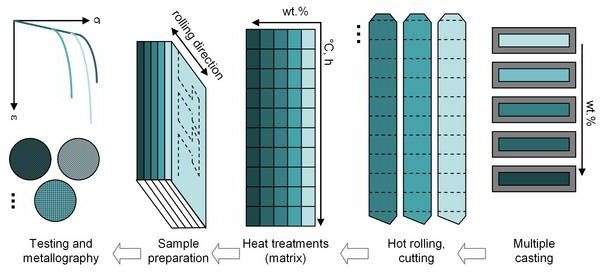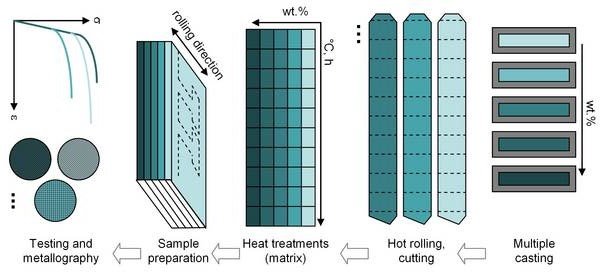Combinatorial Metallurgy and Processing: Rapid Alloy Prototyping
The idea of the group "Combinatorial Metallurgy and Processing" is to develop and deploy innovative methods for the accelerated synthesis, processing and testing of bulk metallic structural materials. The goal is to address the associated basic metallurgical questions and corresponding engineering issues more rapidly and efficiently and thus with a higher throughput than with conventional methods and step-by-step iterations of these parameters. One of the challenges is to produce not only reliable data with a limited amount of method-specific artifacts, but also enable to perform controlled thermo mechanical variations as they greatly influence the microstructure and mechanical properties of structural materials.
Rapid Alloy Prototyping
The group of Hauke Springer successfully developed a method termed Rapid Alloy Prototyping (RAP) which is based on semi-continuous highthroughput bulk casting, rolling, heat treatment and sample preparation techniques and currently allows for the evaluation of the mechanical (tensile and hardness testing) and basic microstructural (optical microscopy, x-ray diffraction) properties of up to 50 material conditions (i.e. 5 different alloy compositions with 10 different thermo-mechanical treatments each) within about 5 days. This quasi simultaneous evaluation enables that critical material parameters can be reliably preselected, simulations verified and transient kinetic states readily investigated. The time between a design idea and the final evaluation of the materials' mechanical and microstructural properties is reduced from several weeks or even months down to hours.
Synthesis and processing of innovative iron based materials
Currently, the focus of the alloy design performed within the group lies on high strength steels with inherent weldability, the generation of local microstructures by targeted creation of local chemical gradients and ultrahigh strength pearlitic steel wires. The design of such novel steels often goes hand in hand with the adaption and development of the synthesis and processing techniques. Furthermore, the early integration of key engineering properties such as weldability can greatly increase the overall scientific efficiency of the alloy design process. Examples for such developments are the installation of a new high power laser facility and an injection system for metallic or ceramic powders in a strip casting machine.

Rapid Alloy Prototyping: The mechanical and basic microstructural properties of up to 50 material conditions (i.e. 5 different alloy compositions with 10 different thermomechanical treatments each) can currently be evaluated within about 5 days.
Maximum flexibility for a multitude of possible experimental conditions
The available instrumentation of the ,,Combinatorial Metallurgy and Processing" group ensures maximum flexibility for a multitude of possible experimental conditions, in order to perform highly controlled scientific experiments as well as material production close to industrial processing. The available equipment for material synthesis covers a range from small charge, high purity levitation and arc melting setups up to induction melting of about 70 kg of steel. Special experimental conditions comprise e.g. rapid solidification techniques, single crystal growth or electron beam remelting. Heat treatments can be performed under greatly varying conditions regarding atmosphere, heating media, heating and cooling rates and sample size. Thermo mechanical processing of materials is done by rolling, forging, swaging or wire drawing.
Lightweight metallic systems, intermetallic materials and bulk metallic glasses
The spectrum of materials ranges from novel lightweight metallic systems such as titanium or magnesium-based alloys with additions of rare-earth elements, intermetallic materials such as Laves phases, to amorphous alloys such as bulk metallic glasses.
Author: Hauke Springer
